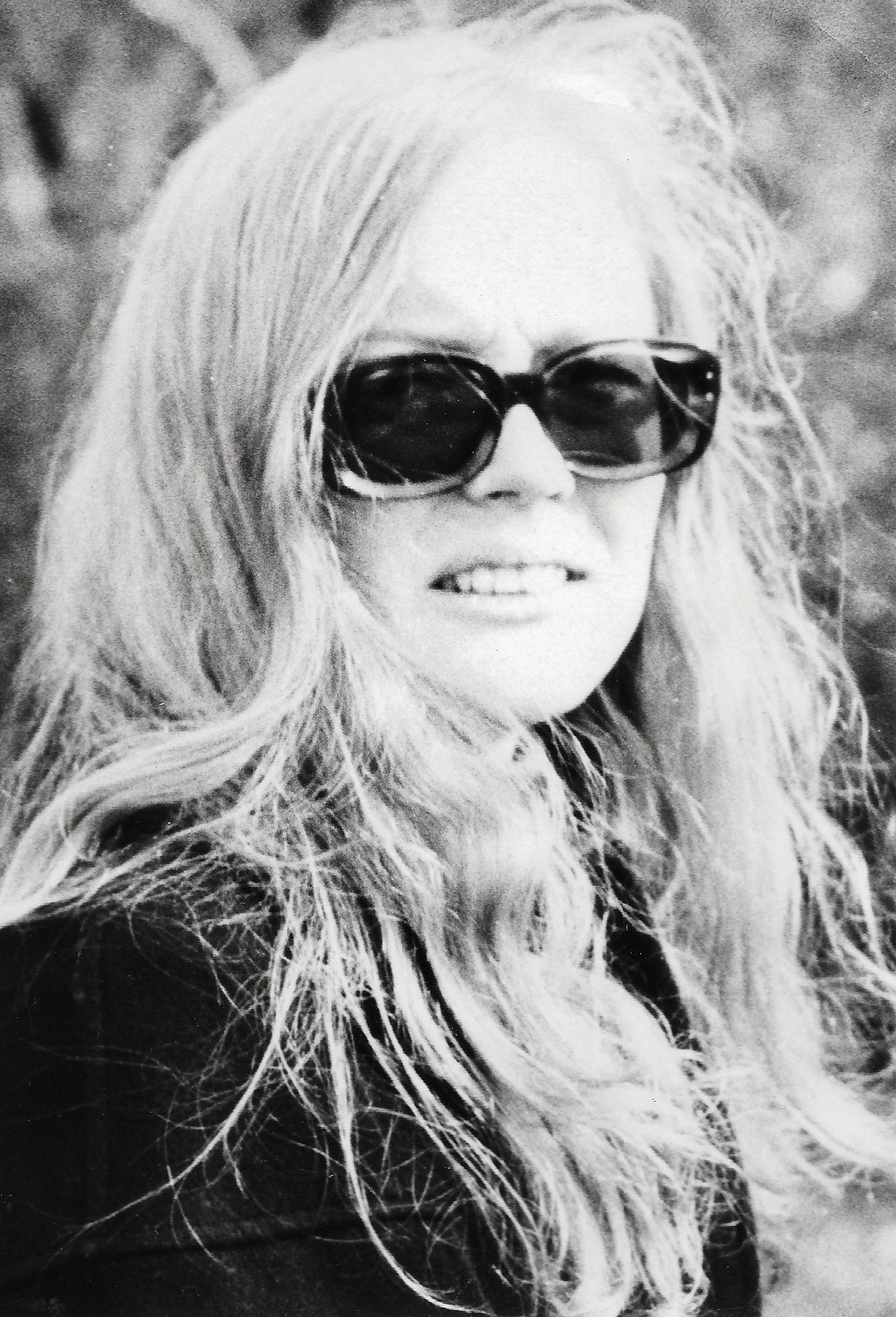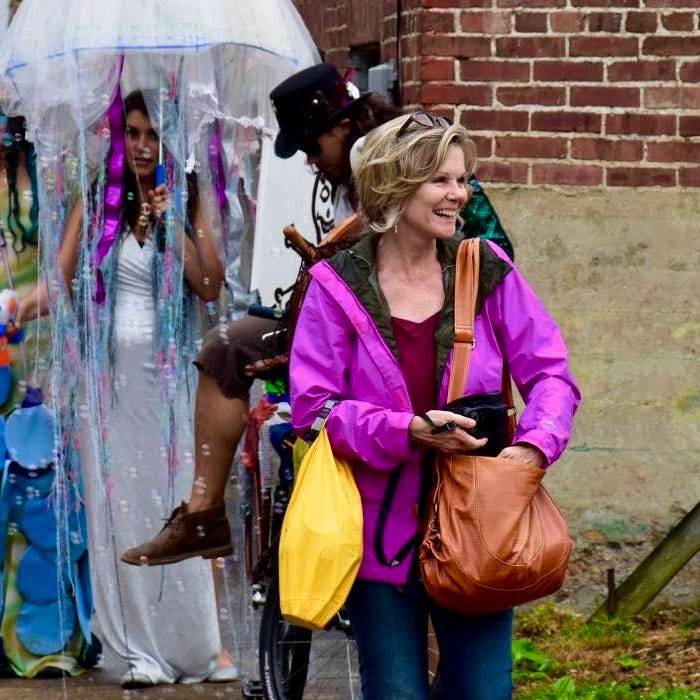Aware from my mother’s phone calls that Karen had slipped into a coma not long after I left, I was finding it hard to concentrate on work. I tried to make myself useful by painting the walls of the documentary workspace, transforming them (with Martin’s consent) from what I considered “renter beige” to a fresh, minimal Scandinavian white. But as I was painting, all I could think about was my sister, lying in hospice, nearly one thousand miles away from me.
Not only was she my big sister, Karen was also my counselor, my mentor, my friend, and my best critic. She was my other self – the older, wiser, more confident, more artistic me I could only dream of being. We were ten years apart but crafted from the same genetic pool and bound together through the shared cultural experiences of a common – and uncommon – upbringing. It was a mutually satisfying relationship. I looked up to her and she looked out for me.
All my life, Karen had been my teacher. She was always there before me, guiding me, giving advice, suggestions, ideas – all cleverly hidden in the guise of telling me what to do. From boyfriends, clothes, makeup, hairstyles, to when I would lose my virginity, my choice of husband, and, of course, anything to do with how I set up my home, she always had an opinion. In fact, I couldn’t remember anything she didn’t have an opinion about.
Ours was a joyous rivalry with constant taunts to each other and the competition in differing fields of creative endeavors. Despite our age difference and the peripatetic ways of our family lifestyle, we always found chunks of time to spend together.
In 1964, our family had moved from a fifty-acre tree farm in rural New Jersey to the heart of London. London in the 60s was magical – Mary Quant & miniskirts, Carnaby Street, the mods & rockers, the Beatles & the Rolling Stones – and my sister took full advantage of it.
When I was eight or nine years old, she and I were walking along a street in Chelsea when a car full of young mods drove by. They leaned out of the window, whistling their appreciation. My sister laughed.
Honeybunch, she said to me. They’re looking at you!
For a hopeful minute, I was excited. Me?!
And then, as the car passed by, I realized that of course it was my sister they were admiring. I think that’s when I first realized how beautiful Karen was with her creamy pale skin, strawberry blonde hair and green eyes.
Karen left London when she was eighteen to attend Pratt Institute in Brooklyn and pursue her interest in design. Before leaving, perhaps as consolation to her sad little sister, she came up with the idea that we would exchange letters using fake names while she was living in New York City. We chose Peter Cook and Dudley Moore, our favorite comedians at the time and stars of the show, Not Only But Also. I was thrilled when the first airletter arrived from New York addressed to “Ms Dudley Fellows.” “Pete” was a better correspondent than I, writing to me often about art school, fashion, New York City, and of course, boys.
In the late 60s, Karen invited me to spend a week with her in New York. She took me to Greenwich Village to see the artists and to Central Park. We shopped at her neighborhood grocery stands and she took me out to small inexpensive restaurants. Being a very pragmatic older sister, she also taught me to clean her “loo” – her idea of rent for the visit.
Years later, in between my high school years, we lived together at our mother’s little A-frame beach house on Long Beach Island for a summer. Karen took her responsibilities (me) very seriously and monitored any possibility of a social life (ie, meeting boys on the beach) quite fiercely. She taught me how to make macaroni & cheese out of a box and we indulged in what would become a decades-long ritual: hand-me-down fashion shows, both of us collapsing in laughter at how easily I could make everything that looked so stylish on her, look so awful on me.
After I graduated from college, she visited me during the years I worked in the Georgetown neighborhood of Washington DC. We watched the latest French foreign films and decided to dress like Catherine Deneuve in The Last Metro. I remember her excitement in a vintage clothing store on Wisconsin Avenue as she tried on a black cocktail dress from the 40s that seemed tailor-made for her curves.
I really missed my time, she said wistfully, turning this way and that, admiring her reflection in the mirror. I look great in these clothes!
Despite the constraints of an unpredictable artist’s income, Karen was capable of spontaneous and overwhelming generosity. After my marriage to Steve ended and I was living in the house with the tulips, she came to visit me and the kids for a week. She and I spent an afternoon at the Torpedo Factory in Old Town – a collection of artists’ studios in a former munitions factory – and both fell in love with the same painting by artist Connie Slack. We sat in two chairs in front of it for some time, gazing at the canvas.
You really like it? Karen asked me. I nodded.
Two hours later, it was hanging in my living room, a riot of colorful flowers lighting up my little house, bringing joy and energy to the space.
“I will own it, she said firmly before she left. “But as I don’t really have the space for it at my place, why don’t you take care of it for me?”
And of course, she never reclaimed it.
Art was her everything, and she was always eager to share it. In her final months, she taught Leif to paint and fire clay. She spent time with Zoë painting shells they found on the beach with watercolors.
During my last night by her side, as I kept watch over her as she struggled for breath, I was torn in half, both wishing her peace but also wanting desperately to cling to what was left of her. There was still so much to do. We had talked about visiting the art museums in New York City together and the many art scenes in Italy. There were so many places I wanted to experience with her.
But it wasn’t to be.
The phone at the documentary workspace rang periodically throughout the morning while I was painting. When it rang at ten minutes past ten, it sounded different to me. There was something in that particular ring. I froze, paintbrush in hand, listening.
Six months earlier, it was Karen who held a paintbrush in her hand when she realized the cancer had returned. Now it was me holding a paintbrush, bracing myself for bad news. Six months between paint brush strokes – as if those two paintbrushes were metaphorical bookends, or perhaps a pair of parenthetical arms wrapped around that precious space of time and moments together, our bittersweet months of final blessings.
Martin answered. Even before he spoke, something inside me already knew this was the call.
And it was. I heard him greet my mother by her name, then fall silent, then softly say a few words of condolence. And then I heard him put down the phone down gently. Everything was still, suspended for a moment. He called out my name quietly.
Over the years, I’ve often wondered how I was able to recognize the ring of that particular call, to distinguish it from all the others that came in that morning, to know that was the one that would carry the news that my sister had just left me. I still don’t know the answer.
All I have is a sense of wonder and gratitude for that simple moment of intuition; one last – and lasting – moment of connection between me and my big sister. Our final, Final Blessing.
[photo of Karen (above) by someone she knew in New York City]
Kristin Fellows is a published writer, world traveler, and a well-seasoned documentary film consultant. When not writing, Kristin can often be found listening to someone’s story or behind the lens of one of her cameras.
More about Kristin @ kristinfellowswriter.com






Thank you! I keep visualizing your story as a docu series that would touch the hearts and spirits of so many. What I think is that you have the gift of writing as a portrait in time. So, whether a book or a film, it's a powerful testimony to love. A palpable portrait!
Yes, the phone call and knowing what is was for. So final. You just can't believe it really happened. I love reading about your memories.